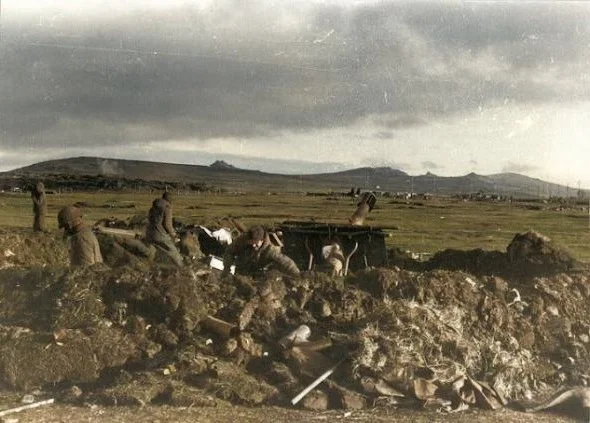
Account of Second Lieutenant Juan Gabino Suárez, Chief of the “last gun” of the 4th Airborne Artillery Group (GAAerot 4)

I share this account once again because Rear Admiral Carlos Hugo Robacio deserves to be remembered as he truly was — by living and reliving a part of his life.
I will never tire of saying it. Never.

Our place in the war: Sapper Hill (Puerto Argentino, Malvinas Islands, Republic of Argentina) — with a forward detachment in San Carlos alongside Battery "A".
A field artilleryman loves to see where his rounds land. He thrives on observing, calculating, correcting. But when you’re the Chief of the Gun Section, that privilege is gone. From the rear —where all you hear are the fire commands and the thunder of the guns— you must imagine the battlefield, reconstruct in your mind what’s unfolding ahead, guided only by instinct, by training... and by doctrine.
That’s when fire adjustment comes alive —the craft of bracketing a target with precision. It's a method as old as it is effective: the first shot, far from being decisive, is merely a starting point. In artillery, a direct hit on the first round proves nothing. Only through disciplined bracketing—first in azimuth, then in range—can effective fire be achieved.

But in the urgency of combat, the temptation to cut corners is always there. One tends to stray from the textbook, from regulation, from what was drilled into you in the classroom. You want to solve everything at once. And that’s where those who forget the fundamentals make their first mistake. Because when the situation is real, and the enemy is advancing, all you have left is what you learned —and held onto.
And then, he appeared: Captain Carlos Hugo Robacio, Commander of Marine Battalion 5. The moment his fire requests began coming in, I knew instantly he was applying doctrine with surgical precision. His Initial Fire Request (IFR) was flawless: the target was clearly described —width, depth, distance, bearing from magnetic north. Everyone in the fire chain knew exactly what had to be done. Tactical clarity radiated through the net. And that kind of clarity inspires. From gun crews to the Fire Direction Center (FDC) and the Fire Support Coordinator (FSC), everyone locked in.

CN Carlos Robacio in Malvinas
I could read his thinking through the rounds.
The first shot landed off to one side.
The second, at the opposite end.
What was he doing?
He was bracketing the target, establishing the axis of correction. Pure doctrine. Pure art.
The third corrected direction.
The fourth refined range.
The fifth: ten rounds, fire for effect.
Not a moment of hesitation. Robacio didn’t ask —he ordered. And every order was exact.
Then came confirmation from the Forward Observer: successful impact. But who exactly were we firing on? These weren’t theoretical targets. We were firing on British troops who had already closed within 150 meters of our lines —some even closer. Robacio had cut the enemy advance in two, separating the forward elements from the main assault force still pushing up from the rear. He bought time —and lives.
And then, the critical moment.
The new coordinates overlapped the exact position of Marine Battalion 5. The FDC hesitated. “We can’t fire there —our own men are on that grid!” But Robacio didn’t flinch:
“They’re among us! Get in your foxholes and open fire. Fire! Fire! Fire!”
The order came out furious, direct, visceral. And it was necessary.

Even with our guns buried, we kept fighting back.
I don’t remember how many volleys we fired on that line —but it was a lot. Hundreds of rounds. Robacio kept pushing them back, forcing the enemy to scatter. And when he sensed it was time, he ordered a fire barrier. Precision calculations. All guns firing on a perfect line. A wall of steel. And he drove them even farther. Until the guns fell silent.
To me, it was a masterclass in fire control. No hesitation. No second-guessing. Robacio owned the battlefield like a conductor with an orchestra —with precision, instinct, and total battlefield awareness. He was a professional. A tactician. A clear-headed combat leader.
But what were the British really trying to do by attacking BIM5? Was it a diversion? A beachhead for a future assault on Port Stanley? A test of our responsiveness?
Even today, this engagement is barely remembered, hardly studied, nearly absent from the official accounts. And yet, it was one of the most technically sound and fiercely fought defenses of the entire war.
I hope this testimony serves to highlight the professional excellence of Captain Robacio, his tactical brilliance, and his nerve under fire. We never had the chance to work together before the war —but in those days, I could read his mind through every shot fired.
And in artillery, that’s worth more than a thousand words.

One of our artillery guns —in those first days, our assigned combat position— might well be the emblematic one. Maybe because of where it stood. The fence posts were still upright, and the comrades of BIM 5 were up ahead, still building their own defenses.
Forgive me for bringing back these memories —memories of those howitzers that once held back the British advance, firing until there was nothing left to shoot.
(Sapper Hil, Puerto Argentino, Republic of Argentina)
